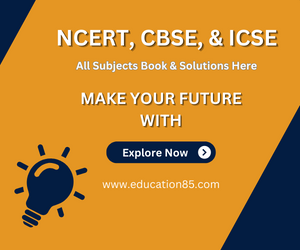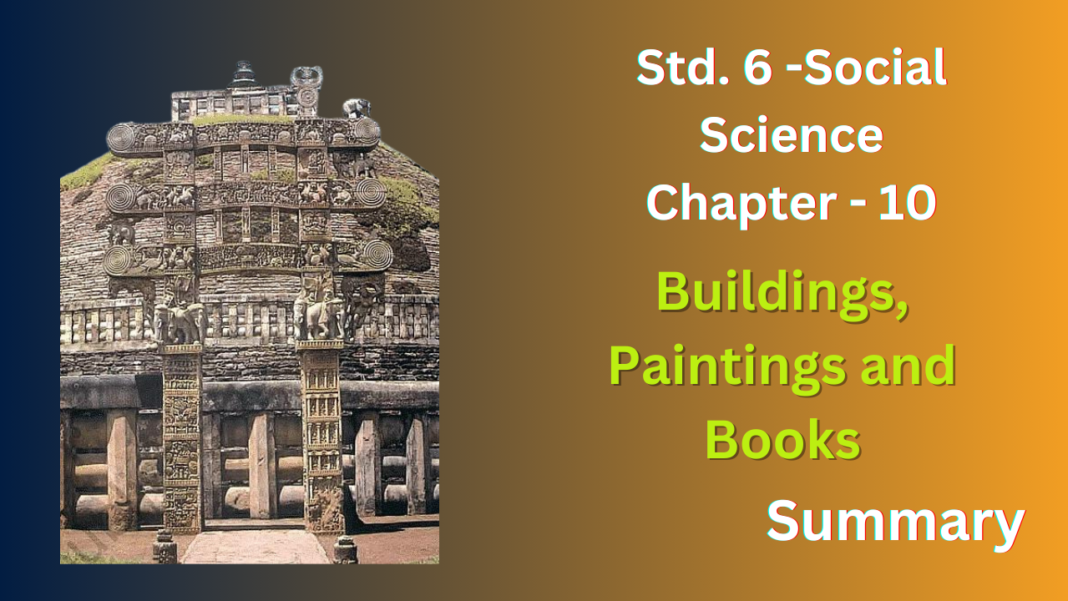NCERT Solutions for Class 6 History Chapter 10
The chapter Buildings Paintings and Books explores different sources historians use to learn about the past, focusing on:
Buildings:
- The chapter might discuss different types of buildings constructed in ancient India, such as:
- Stupas: Mound-like structures built to enshrine relics of the Buddha. Examples include Sanchi Stupa and Bharhut Stupa.
- Temples: Places of worship for Hindus, Jains, and Buddhists. Examples include the Shore Temple (Mamallapuram), Brihadeswara Temple (Thanjavur), and Kailashnath Temple (Ellora).
- Pillars: Used for various purposes, including marking trade routes (e.g., Ashoka’s pillars) or commemorating events.
- By studying these buildings, historians can learn about:
- Religious beliefs and practices.
- Architectural styles and techniques.
- The lives of rulers and the common people.
Paintings:
- The chapter might introduce famous cave paintings, like those found at Ajanta and Ellora. These caves depict stories from the Jataka tales, Buddhist legends, and Hindu epics like the Ramayana and Mahabharata.
- Studying these paintings helps us understand:
- Religious themes and stories.
- Clothing, hairstyles, and ornaments of people in ancient India.
- Art styles and techniques that were popular.
Books:
- The chapter might mention some of the earliest Indian writings, including:
- The Vedas: Ancient hymns and religious texts.
- The Epics: The Ramayana and Mahabharata, long epic poems with religious and social themes.
- Jataka Tales: Stories about the Buddha’s previous births that teach moral lessons.
- These books provide insights into:
- Religious beliefs and philosophies.
- Social customs and practices of the time.
- Literature and storytelling traditions.
NCERT Solutions for Class 6 History Chapter 10
Let’s recall
1.Match the following
| Column I | Column II |
| Stupa | Place where the image of the deity is installed |
| Shikhara | Mount |
| Mandapa | Circular path around the stupa |
| Garbhagriha | Place in temples where people could assemble |
| Pradakshina petha | Tower |
Ans :
| Column I | Column II |
| Stupa | Mount |
| Shikhara | Tower |
| Mandapa | Place in temples where people could assemble |
| Garbhagriha | Circular path around the stupa |
| Pradakshina petha | Place where the image of the deity is installed |
2. Fill in the blanks
(a)____ was a great astronomer.
(b) Stories about gods and goddesses are found in the _____.
(c) ______is recognised as the author of the Sanskrit Ramayana.
(d) ____and___ are two Tamil epics.
Ans : (a) Aryabhata
(b) Puranas or Epics (both are valid answers).
(c) Valmiki
(d) Silappadhikaram and Manimekalai
Let’s discuss
3. Make a list of the chapters in which you find mention of metal working. What are the metals objects mentioned or shown in those chapters?
Ans : (a) Potential Chapters Discussing Metalworking:
- Chapter 1: In the Earliest Cities (This chapter likely focuses on the Indus Valley Civilization known for bronzework)
- Chapter 4: Vital Villages, Thriving Towns (This chapter might mention metal tools used by artisans)
- Chapter 5: Kingdoms, Kings, and The Early Republic (This chapter could discuss the use of metals in weapons or even currency)
- Chapter 7: Traders, Kings, and Pilgrims (This chapter might depict metal goods being traded)
- Chapter 8: New Empires and Kingdoms (Similar to Chapter 5, this chapter could mention metals used for weapons or tools)
- Chapter 11: Buildings, Paintings and Books (This chapter might show metal used in statues, decorative elements, or utensils depicted in artwork)
(b) Metals Likely Mentioned in These Chapters:
- Copper (A foundational metal used in early bronze)
- Tin (Alloyed with copper to create bronze)
- Bronze (The most common metal used in the Indus Valley Civilization)
- Iron (Introduced later, potentially mentioned in later chapters)
- Silver (Might be discussed in reference to early coinage)
- Gold (Likely mentioned for jewelry or decorative items)
- Ivory (While not a metal, it might be mentioned alongside metal objects as a valuable material)
4. Read the story on page 104. In what ways is the monkey king similar to or different from the kings you read about in Chapters 5 and 9?
Ans : Similarities:
- Leadership: Both the Monkey King and the kings from Chapters 5 and 9 hold positions of leadership. They are likely responsible for the well-being of their subjects.
- Focus on the People: Both the Monkey King and some of the kings you read about might be concerned with the welfare and protection of their people.
Differences:
- Origin: The Monkey King might be a mythical or fictional figure, while the kings from Chapters 5 and 9 were likely historical figures.
- Source of Power: The Monkey King’s power might come from supernatural abilities, while the kings from Chapters 5 and 9 likely derived their power from heredity or military might.
- Ruling Style: The Monkey King’s ruling style might be more informal or even playful, depending on the story. The kings from Chapters 5 and 9 might have had a more formal and structured system of governance.
- Focus on War: The kings from Chapters 5 and 9 might be involved in wars and conquests, while the story of the Monkey King might not emphasize warfare.
5. Find out more and tell a story from one of the epics.
Ans : The Tale of Hanuman and the Burning of Lanka
The Ramayana, one of India’s most revered epics, tells the tale of Rama, a prince who is exiled to the forest with his wife Sita and brother Lakshmana. The demon king Ravana kidnaps Sita, and Rama sets out on a quest to rescue her.
One of Rama’s most loyal companions is Hanuman, a powerful vanara (monkey-like humanoid) with incredible strength and the ability to fly. Here’s a part of the story where Hanuman plays a pivotal role:
Hanuman’s Infiltration:
Rama and Lakshmana form an alliance with Sugriva, the king of the vanaras. Hanuman volunteers to search for Sita in Lanka, Ravana’s heavily guarded island kingdom. Using his ability to shrink himself to the size of an insect, Hanuman infiltrates Lanka and locates Sita imprisoned in the Ashok Vatika (grove). He consoles her, assuring her that Rama will come for her.
Encounter with Ravana:
While searching for Sita, Hanuman is captured by Ravana’s guards. He boldly declares his identity and purpose, refusing to back down. He even challenges Ravana in his own court, displaying his immense strength and unwavering loyalty to Rama.
The Burning of Lanka:
As punishment, Ravana orders Hanuman’s tail to be set on fire. However, Hanuman uses the burning tail to his advantage. He leaps across Lanka, setting fire to the city as revenge for the insult to Rama.
Returning to Rama:
Hanuman returns to Rama, informing him of Sita’s location and the strength of Lanka’s defenses. He also presents a piece of Sita’s jewelry as proof of his encounter. This information becomes crucial for Rama’s plan to rescue Sita and defeat Ravana.
NCERT Solutions for Class 6 History Chapter 10
FAQ’s
What topics are covered in Class 6 History Chapter 10 : “Buildings Paintings and Books”?
Class 6 History Chapter 10 explores the cultural heritage of ancient civilizations through topics such as architectural marvels, artistic expressions in paintings, and the significance of books in preserving historical knowledge.
How can NCERT solutions for Class 6 History Chapter 10 help in understanding buildings, paintings, and books?
NCERT solutions offer detailed explanations and analyses of the architectural styles, artistic themes, and literary contributions discussed in the chapter, helping students understand the cultural and historical significance of buildings paintings and books.
Where can I find NCERT solutions for Class 6 History Chapter 10?
NCERT solutions for Class 6 History Chapter 10 can be found online or in study materials provided by educational platforms like education85 or institutes specializing in academic resources.
When should I refer to NCERT solutions for Class 6 History Chapter 10?
NCERT solutions are beneficial for reinforcing learning, clarifying doubts, and preparing for exams. They can be used alongside regular study or as a revision tool before assessments to enhance understanding of the cultural heritage discussed in the chapter.
What specific examples are discussed in Class 6 History Chapter 10 regarding buildings, paintings and books?
Class 6 History Chapter 10 discusses various examples of architectural wonders, famous paintings, and significant literary works from ancient civilizations, offering insights into the rich cultural heritage of human societies.









